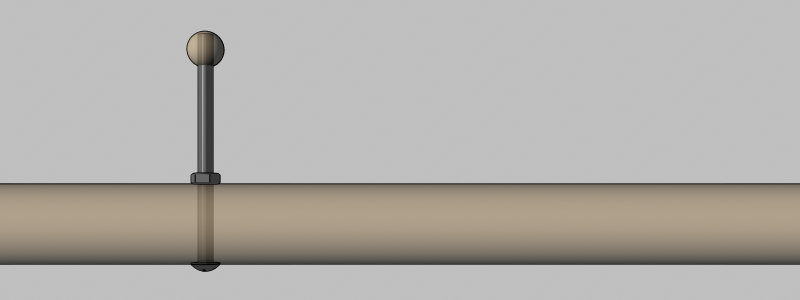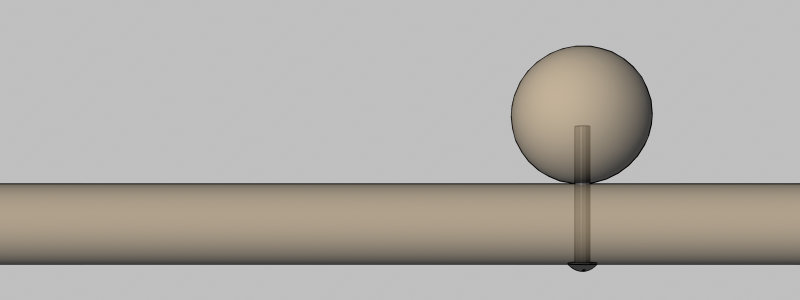Eclipse Stick
An eclipse stick is a scale model of the Earth-Moon system that, when aligned with the Sun, produces a scaled eclipse shadow. They're pretty easy to make.
 Testing my eclipse stick in the parking lot. (Photos by Eleni Kostis)
Testing my eclipse stick in the parking lot. (Photos by Eleni Kostis)
 The shadow has the same umbra and penumbra as a real eclipse.
The shadow has the same umbra and penumbra as a real eclipse.
I was inspired to build one of these by a post on Daniel Fischer's astronomy blog. Daniel was reporting on a poster presented by physicist Ricardo Bernatene at the Segundo Workshop de Difusión y Enseñanza de la Astronomía in Esquel, Argentina, part of the public outreach activities leading up to the February 26, 2017 annular solar eclipse visible in Patagonia and southern Africa.
The Recipe
This is how I made my eclipse stick, using what was easy to find at my nearby craft and hardware stores.
- 10 mm wooden bead
- 1.5 inch (3.8 cm) wooden ball
- 7/8" × 48" wooden dowel
- #8 round head machine screw, 1.5"
- #8 round head machine screw, 2.5", and nut
- 1/8" and 5/32" drill bits
With the 5/32" drill bit, drill two holes in the dowel, 42 inches apart. Thread a 2.5" screw through one hole and secure with a nut. Thread a 10 mm bead onto the end of the screw. With the 1/8" drill bit, drill a hole about halfway through the 1.5" ball. Thread a 1.5" screw through the other end of the dowel, then screw on the ball.
 It isn't strictly necessary to make the two screw holes parallel, but
it looks better that way.
It isn't strictly necessary to make the two screw holes parallel, but
it looks better that way.
 Secure the screw on the Moon side with a nut. Use a Phillips screwdriver
while holding the nut with a wrench or pliers.
Secure the screw on the Moon side with a nut. Use a Phillips screwdriver
while holding the nut with a wrench or pliers.
 Screw down the ball until it's snug with the dowel.
Screw down the ball until it's snug with the dowel.
The Reasoning
Briefly, the size of the Moon bead sets the scale of the model. The Earth should be 103 to 109 Moons away, and about 3.7 times as big. The rest is just engineering — choosing some kind of stick or pipe, and figuring out how to attach the Moon and the Earth.
The Moon's distance from the Earth can vary from 356,500 km to 406,700 km, or about 103 to 117 Moon diameters. Total solar eclipses happen when the Moon is at the closer end of that range, since when it's farther away, it isn't quite big enough to cover the entire Sun.
During the August 21, 2017 eclipse, the Moon is about 372,000 km away, or 107 Moon diameters. For my 10 mm Moon beads, this translates to a scale distance of 107 cm or 42 inches, a distance comfortably accomodated on a 48-inch dowel. The Earth on this scale should have a diameter of 3.7 cm. The 1.5" wooden balls I found are really close, just slightly larger at 3.8 cm.
As you can see, the length of the dowel and the size of the Earth ball follow from the size of the Moon beads I happened to find. I used #8 screws because that's the screw that fits snugly in the existing holes in the Moon beads. A 7/8" dowel lets just enough of a 1.5" screw through to securely attach the Earth ball, and a 2.5" screw gets the Moon far enough away from the dowel so that your hand doesn't interfere with the shadow. I chose wood because I like how it looks and it's easy to work with. The bead and the ball thread onto the screws in exactly the same way as wooden cabinet knobs.
Craft stores have beads and balls in lots of different sizes and materials. They tend not to have dowels or sticks longer than 36 inches, but you can find the 48-inch dowels at the hardware store. Or use a 7 mm bead, a 1" ball, and a spacing of 29.5", maybe on a yardstick with toothpicks and hot glue. I'm thinking about making one with a pipe joint in the middle, so that it can be disassembled into two pieces that fit in a suitcase.
Update: I made a portable eclipse stick from the mast of a broken floor lamp.
 Modular eclipse stick made from the mast of a floor lamp.
Modular eclipse stick made from the mast of a floor lamp.
The base of the torchiere style floor lamp in my office included a ring of concrete as ballast, and it just crumbled one day. The steel mast of the lamp unscrewed into four sections, each about 18 inches long. Three of the four sections make a stick long enough to use my bead Moon and wooden sphere Earth. Adding the fourth section at the Earth end gets the Earth up off the ground, while adding it at the Moon end makes it a little easier to hold.
Slippery enameled steel is a little trickier to drill than the wooden dowel, but other than that, this eclipse stick went together just like the first one. I brought this version with me to the American Astronomical Society Eclipse 2017 workshop V in Columbia, South Carolina.
